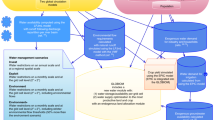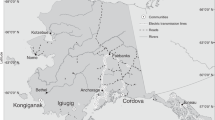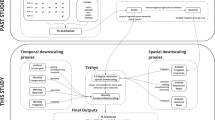Abstract
The literature emphasizes the important relationships between the consumption and production of food, energy and water, and environmental challenges such as climate change and loss of biodiversity. New tools are needed to analyse the future dynamics of this nexus. Here, we introduce a set of model-based scenarios and associated Sankey diagrams that enable analysis of the relevant relationships and dynamics, as well as the options to formulate response strategies. The scenarios show that if no new policies are adopted, food production and energy generation could further increase by around 60%, and water consumption by around 20% over the period 2015–2050, leading to further degradation of resources and increasing environmental pressure. Response strategies in terms of climate policies, higher agricultural yields, dietary change and reduction of food waste are analysed to reveal how they may contribute to reversing these trends, and possibly even lead to a reduction of land use in the future.
This is a preview of subscription content, access via your institution
Access options
Access Nature and 54 other Nature Portfolio journals
Get Nature+, our best-value online-access subscription
$29.99 / 30 days
cancel any time
Subscribe to this journal
Receive 12 digital issues and online access to articles
$119.00 per year
only $9.92 per issue
Buy this article
- Purchase on Springer Link
- Instant access to full article PDF
Prices may be subject to local taxes which are calculated during checkout




Similar content being viewed by others
Data availability
The data relating to the scenarios described in this paper are available for download from https://models.pbl.nl/image/index.php/Download. The data supporting the figures are available from the IMAGE website at PBL (https://go.nature.com/32CZSLh).
References
De Stercke, S. Dynamics of Energy Systems: A Useful Perspective IIASA Interim Report IR-14-013 (IIASA, 2014).
FAOSTAT (UN Food and Agriculture Organization, 2017); http://www.fao.org/faostat/en/#home
Reid, W. et al. Millennium Ecosystem Assessment Synthesis Report (Island Press, 2005).
Hoff, H. Understanding the Nexus: Background Paper for the Bonn2011 Nexus Conference (Stockholm Environment Institute, 2011).
Howells, M. et al. Integrated analysis of climate change, land-use, energy and water strategies. Nat. Clim. Change 3, 621–626 (2013).
Momblanch, A. et al. Untangling the water–food–energy–environment nexus for global change adaptation in a complex Himalayan water resource system. Sci. Total Environ. 655, 35–47 (2019).
Welsch, M. et al. Adding value with CLEWS—modelling the energy system and its interdependencies for Mauritius. Appl. Energy 113, 1434–1445 (2014).
Hussien, W. A., Memon, F. A. & Savic, D. A. An integrated model to evaluate water–energy–food nexus at a household scale. Environ. Model. Softw. 93, 366–380 (2017).
Bleischwitz, R. et al. Resource nexus perspectives towards the United Nations Sustainable Development Goals. Nat. Sustain. 1, 737–743 (2018).
Konadu, D. et al. Not all low-carbon energy pathways are environmentally “no-regrets” options. Glob. Environ. Change 35, 379–390 (2015).
Johnson, N. et al. Integrated solutions for the water-energy-land nexus: are global models rising to the challenge? Water 11, 2223 (2019).
Obersteiner, M. et al. Assessing the land resource–food price nexus of the Sustainable Development Goals. Sci. Adv. 2, e1501499 (2016).
Byers, E. et al. Global exposure and vulnerability to multi-sector development and climate change hotspots. Environ. Res. Lett. 13, 055012 (2018).
Oberle, B. et al. Global Resources Outlook 2019: Natural Resources for the Future We Want (United Nations Environment Programme & International Resource Panel, 2019).
Nilsson, M., Griggs, D. J. & Visbeck, M. Policy: map the interactions between Sustainable Development Goals. Nature 534, 320–322 (2016).
Stafford-Smith, M. et al. Integration: the key to implementing the Sustainable Development Goals. Sustain. Sci. 12, 911–919 (2017).
Rockström, J. et al. A safe operating space for humanity. Nature 461, 472–475 (2009).
Transforming our World: the 2030 Agenda for Sustainable Development (United Nations, 2015).
Transformations to Achieve the Sustainable Development Goals (IIASA & The World in 2050, 2018).
Foley, J. A. et al. Solutions for a cultivated planet. Nature 478, 337–342 (2011).
Stehfest, E., Van Vuuren, D. P., Kram, T. & Bouwman, A. F. Integrated Assessment of Global Environmental Change with IMAGE 3.0 - Model Description and Policy applications (PBL Netherlands Environmental Assessment Agency, 2014); https://models.pbl.nl/image/index.php/Welcome_to_IMAGE_3.0_Documentation
Bijl, D. L. et al. A physically-based model of long-term food demand. Glob. Environ. Change 45, 47–62 (2017).
Van Vuuren, D. P. et al. Energy, land-use and greenhouse gas emissions trajectories under a green growth paradigm. Glob. Environ. Change 42, 237–250 (2017).
Schmidt, M. The Sankey diagram in energy and material flow management: part I: history. J. Ind. Ecol. 12, 82–94 (2008).
Schmidt, M. The Sankey diagram in energy and material flow management—part II: methodology and current applications. J. Ind. Ecol. 12, 173–185 (2008).
Curmi, E. et al. Visualising a stochastic model of Californian water resources using Sankey diagrams. Water Resour. Manag. 27, 3035–3050 (2013).
Alexander, P. et al. Losses, inefficiencies and waste in the global food system. Agric. Syst. 153, 190–200 (2017).
Bijl, D. L., Bogaart, P. W., Kram, T., de Vries, B. J. M. & van Vuuren, D. P. Long-term water demand for electricity, industry and households. Environ. Sci. Policy 55, 75–86 (2016).
Smith, P. et al. Competition for land. Phil. Trans. R. Soc. B Biol. Sci. 365, 2941–2957 (2010).
Daioglou, V., Stehfest, E., Wicke, B., Faaij, A. & van Vuuren, D. P. Projections of the availability and cost of residues from agriculture and forestry. GCB Bioenergy 8, 456–470 (2016).
GEA The Global Energy Assessment: Toward a More Sustainable Future (Cambridge Univ. Press, 2012).
Riahi, K. et al. The Shared Socioeconomic Pathways and their energy, land use, and greenhouse gas emissions implications: an overview. Glob. Environ. Change 42, 153–168 (2017).
Tilman, D. & Clarke, M. Global diets link environmental sustainability and human health. Nature 515, 518–522 (2014).
Smith, P. et al. How much land based greenhouse gas mitigation can be achieved without compromising food security and environmental goals? Glob. Change Biol. 19, 2285–2302 (2013).
Alexander, P. et al. Drivers for global agricultural land use change: the nexus of diet, population, yield and bioenergy. Glob. Environ. Change 15, 138–147 (2015).
Stehfest, E. et al. Climate benefits of changing diet. Clim. Change 95, 83–102 (2009).
Bijl, D. L. et al. A physically-based model of long-term food demand. Glob. Environ. Change 45, 47–62 (2017).
Food, Planet, Health. Healthy Diets from Sustainable Food Systems (The EAT-Lancet Commission, 2019); https://go.nature.com/2NDRXJ6
Leahy, E., Lyons, S. & Tol, R. An Estimate of the Number of Vegetarians in the World ESRI Working Paper 340 (Economic and Social Research Institute, 2010).
Röös, E. et al. Protein futures for Western Europe: potential land use and climate impacts in 2050. Reg. Environ. Change 17, 367–377 (2017).
Neumann, K. & Verburg, P. H. & Stehfest, E. & Müller, C. The yield gap of global grain production: a spatial analysis. Agric. Syst. 103, 316–326 (2010).
Rosegrant, M. W. et al. Agriculture at a Crossroads: Global Report (eds McIntyre, B. D. et al.) (Island Press, 2009).
Mueller, N. D. X. et al. Closing yield gaps through nutrient and water management. Nature 490, 254–257 (2012).
Gustavsson, J., Cederberg, C., Sonesson, U., van Otterdijk, R. & Meybeck, A. Global Food Losses and Food Waste (FAO, 2011).
Clarke, L. et al. in Climate Change 2014: Mitigation of Climate Change (eds Edenhofer, O. et al.) 414–510 (Cambridge Univ. Press, 2014).
Hejazi, M. I. et al. 21st century United States emissions mitigation could increase water stress more than the climate change it is mitigating. Proc. Natl Acad. Sci. USA 112, 10635–10640 (2015).
Engel, E. Die productions- und consumtionsverhältnisse des Königreichs Sachsen. Z. Stat. Bur. Konig. Sachsischen Min. Inner. 8–9, 28–29 (1857).
Daioglou, V., van Ruijven, B. J. & van Vuuren, D. P. Model projections for household energy use in developing countries. Energy 37, 601–615 (2012).
Gustavsson, J., Cederberg, C., Sonesson, U. & Emanuelsson, A. The Methodology of the FAO Study: Global Food Losses and Food Waste – Extent, Causes and Prevention (SIK—The Swedish Institute for Food and Biotechnology, 2013).
Van Vuuren, D. P. et al. Stabilizing greenhouse gas concentrations at low levels: an assessment of reduction strategies and costs. Clim. Change 81, 119–159 (2007).
Girod, B., van Vuuren, D. P. & Deetman, S. Global travel within the 2 °C climate target. Energy Policy 45, 152–166 (2012).
Van Ruijven, B. J. et al. Long-term model-based projections of energy use and CO2 emissions from the global steel and cement industries. Resour. Conserv. Recy. 112, 15–36 (2016).
Bondeau, A. et al. Modelling the role of agriculture for the 20th century global terrestrial carbon balance. Glob. Change Biol. 13, 679–706 (2007).
Gerten, D. Asynchronous exposure to global warming: freshwater resources and terrestrial ecosystems. Environ. Res. Lett. 8, 034032 (2013).
Meinshausen, M., Raper, S. C. B. & Wigley, T. M. L. Emulating coupled atmosphere–ocean and carbon cycle models with a simpler model, MAGICC6—part 1: model description and calibration. Atmos. Chem. Phys. 11, 1417–1456 (2011).
Fricko, O. et al. The marker quantification of the Shared Socioeconomic Pathway 2: a middle-of-the-road scenario for the 21st century. Glob. Environ. Change 42, 251–267 (2017).
Alexandratos, N. & Bruinsma, J. World Agriculture Towards 2030/2050: The 2012 Revision (UN Food and Agriculture Organization, 2012).
World Energy Outlook 2015 (International Energy Agency, 2015).
Willett, W. C. & Skerrett, P. J. Eat, Drink, and Be Healthy: The Harvard Medical School Guide to Healthy Eating (Free Press, 2005).
Kummu, M. et al. Lost food, wasted resources: global food supply chain losses and their impacts on freshwater, cropland, and fertiliser use. Sci. Total Environ. 438, 477–489 (2012).
Acknowledgements
The research presented in this Analysis benefited from funding under the European Union’s Horizon 2020 research and innovation programme, under grant agreement no 689150 SIM4NEXUS and the PICASSO project (EU ERC, contract 819566).
Author information
Authors and Affiliations
Contributions
D.P.V.V. and D.L.B. designed the experiments. All authors contributed to the scenario analysis and the writing of the paper.
Corresponding author
Ethics declarations
Competing interests
The authors declare no competing interests.
Additional information
Publisher’s note Springer Nature remains neutral with regard to jurisdictional claims in published maps and institutional affiliations.
Supplementary information
Supplementary Information
Supplementary Figs. 1–3, Table 1 and references.
Rights and permissions
About this article
Cite this article
Van Vuuren, D.P., Bijl, D.L., Bogaart, P. et al. Integrated scenarios to support analysis of the food–energy–water nexus. Nat Sustain 2, 1132–1141 (2019). https://doi.org/10.1038/s41893-019-0418-8
Received:
Accepted:
Published:
Issue Date:
DOI: https://doi.org/10.1038/s41893-019-0418-8



